|
|
|
|
|
|
|
|
 |
|
 |
|
|
 |
|
|
|
Kosrae State, FSM - June to July 1999
June 29, 1999
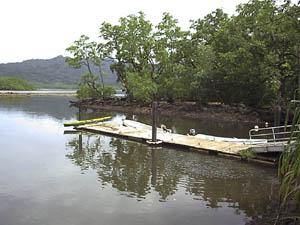
We left from the Utwe dock
Our boat left Utwe dock in the morning. This will be a new route to Walung for me, going around the southern end of the island; usually, we leave from Okat dock, by the airport, which is at the northern end of the west coast. (Walung is at the southern end.) The trip was uneventful and had to proceed outside the reef. Here there is really no question of traveling inside the reef, because that reef is right up against the shoreline.
 We (Stan, his wife Magdalyn, and me) arrived at low tide, so Moses dropped us just inside the reef, at a point as far as his boat would take us. We then had to walk to shore from there, but the water was less than knee deep. Stan had bought a tuna from Moses and was bringing it with us to the site for today's lunch and dinner. We passed a lot of starfish and sea slugs lounging about on the reef, and a ton of fish. Walung is known as good fishing grounds. We (Stan, his wife Magdalyn, and me) arrived at low tide, so Moses dropped us just inside the reef, at a point as far as his boat would take us. We then had to walk to shore from there, but the water was less than knee deep. Stan had bought a tuna from Moses and was bringing it with us to the site for today's lunch and dinner. We passed a lot of starfish and sea slugs lounging about on the reef, and a ton of fish. Walung is known as good fishing grounds.
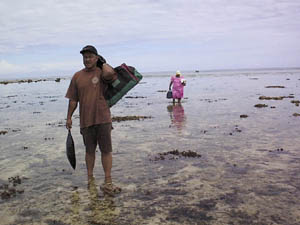
Stan and his wife coming ashore
The compound at which we are staying is managed by Elio Nena. He has turned over three houses to us. One, the main house, has a concrete floor and is enclosed on all sides; the second is the kitchen, an open-air shed with a sand floor that also serves as a sleeping house; and a third, a smaller resting house just down the beach. Stan, Magdalyn and I staked out the kitchen as our sleeping quarters; the crew spread themselves out between the other two houses.

Our kitchen at Walung
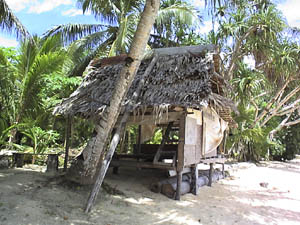
Our resting house at Walung
There is no electricity in Walung, so cooking is over wood fires. In the kitchen there is a raised grill in which most of the cooking takes place, and there is also an um, in which breadfruit (predominantly) is cooked. Water is piped in from the dam in the interior mountains, but it is not potable; drinking water is from a rain catchment system. Elio, our host, seems to make a living by catching fish and selling bananas and other goods grown on the land. These he will take to markets in Utwe or Tafunsak by canoe, a trip that will last quite some time. During our stay this week, he took off one evening at high tide (more like 3 in the morning) to take bananas to market in Utwe, and didn't get back until the evening.
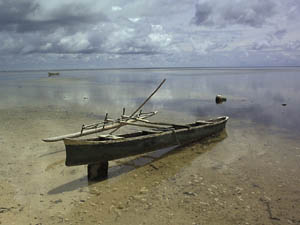
A canoe at Walung
 At the site, the crew continued clearing while Stan and I began a more systematic reconnaissance, flagging areas and features of interest. These areas consisted mainly of midden concentrations (and there are a lot of those; I suspect the entire site is covered with midden), stray alignments of coral and basalt boulders nearly buried in the sand, artifacts (mainly debris from working Tridacna shell), and a very large core of Tridacna (the hinge portion). Stan stumbled across another coral boulder outline of a foundation, near the Tridacna core; so we are gradually seeing a picture of use and activity emerge as the ground is exposed little by little with the clearing. The site is definitely bigger than any other compound on the island. Stan made that comment, and he has been working in the field here for nearly 20 years. At the site, the crew continued clearing while Stan and I began a more systematic reconnaissance, flagging areas and features of interest. These areas consisted mainly of midden concentrations (and there are a lot of those; I suspect the entire site is covered with midden), stray alignments of coral and basalt boulders nearly buried in the sand, artifacts (mainly debris from working Tridacna shell), and a very large core of Tridacna (the hinge portion). Stan stumbled across another coral boulder outline of a foundation, near the Tridacna core; so we are gradually seeing a picture of use and activity emerge as the ground is exposed little by little with the clearing. The site is definitely bigger than any other compound on the island. Stan made that comment, and he has been working in the field here for nearly 20 years.
Both of us came to the conclusion that the site will have to be mapped in detail, nearly stone for stone, at some point. It is a task much too large for our time here, unfortunately. All we can do at this point is map those features and significant areas we have identified, and obtain some subsurface information; at least enough to provide some concrete evidence on the significance of this place. The overall impression I am forming of the site is that its size, location, and isolation suggest it was an administrative center of some sort, an important place on this part of this island and deserving of its name, the Fortress of Solitude.
We continue tomorrow with the clearing and reconnaissance.
After work the crew occupies themselves with various activities, including card playing, fishing just off shore with both line and net, or making their way over to the next compound for an invigorating game of volleyball.

The crew playing cards
As the sun begins to set, the lanterns are prepared for the evening, firewood is cut and the stove already has a blazing fire going. All throughout Walung, lamps and fires are being lit in the scattered households. To the north, you can see Okat dock and the airport lit up with their lights; but here, it is a subtler light. Kids are running around on the beach with torches, splashing in the water, dogs are starting to nest in the sand. Sunsets are beautiful on this side of the island, as the ocean seems particularly calm, smooth and nearly glassy. You can look out toward the horizon, beyond the reef, and see this moving line of swells; it kind of looks like dunes in a desert. The horizon is never fixed, but presents a shifting, changing line with the movement of the waves and currents.
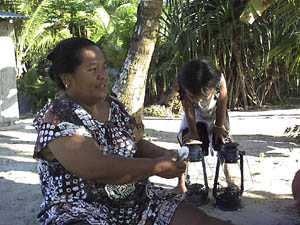
Magdalyn and Mayleen Andrew preparing the lanterns
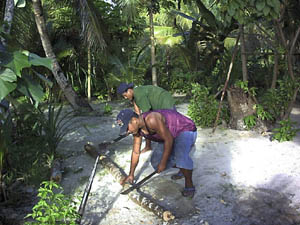
The boys cutting our firewood
Oh, one more thing -- the toilet is next to the pig pen. Whenever you use the toilet, you get serenaded by the pigs who squeal at you in various tones, high and low, big squeals and little squeaks.
June 30, 1999
I woke with the sunrise, watching the lagoon slowly emerge from the darkness as the sun moved over the interior hills of the island and looking at the clouds in the sky through a pandanus. Was it going to rain, I wondered? It did, but just a little; it had passed before anyone else stirred. Magdelyn was up shortly after that, starting a fire and putting some water on to boil for coffee and tea. We had rolls from the bakery (we brought them with us) for breakfast, although some of the crew ate leftover rice, fish and whatever else they could get their hands on.
At the site today, the crew completed the clearing. When the last bush was felled, I put them to work actually picking the trimmings off the ground and actually exposing the ground surface. Yesterday, Stan and I were practically walking six or more inches off the ground, on top of all the fallen brush. We could only get limited views of exposed patches of ground, and from our own efforts in stacking the brush in nearby piles. We located more foundations, more midden, more artifacts. At one foundation, in the northwest corner of the site, a large fish vertebra was resting nearby; our midden is taking shape little by little and seems to consist predominately of shellfish remains (both bivalves and gastropods) and now fish. I expect more tangible midden remnants to emerge once we start excavating; for instance, we should, I think, start to see some bird bone, maybe turtle, maybe dog and rat, lizard and possibly eel. That, of course, is just hopeful speculation.
I had two of the crew begin excavating a stratigraphic trench. I think I will be putting three into the site to get an overall impression of the stratigraphy across the extent of this place.
So far, the pattern that is emerging is one where small platforms and foundations appear against the compound wall. Only one foundation so far stands well inside the compound; it is in the southeast quadrant. It is a coral alignment, with midden mixed with fire-cracked rock and what looks like coral gravel paving accumulated just outside the alignments, as if swept outside the structure. Another area in the northern half of the compound looks like a large feasting area (the midden is particularly thick over the ground), but instead of stone walls outlining the area, there are breadfruit trees. This sort of pattern is reminiscent of Melanesian-type communal areas. Stan says, however, that such a pattern does not appear elsewhere on the island; but then neither does this kind of site. Just outside three of the four corners of the compound wall are smaller foundations, each with their own midden accumulations; and still farther outside the compound wall (to the south) is the platform I stumbled across a couple of weeks ago that we are now interpreting as a series of graves.
The site is becoming more interesting as it comes into view with the removal of the brush.

Stan building the um
After work, Stan built up the um to cook breadfruit. The lowest layer is lined with coconut husks and small sticks used to get a fire going; these are then lined with rocks, with more larger pieces of wood on top of these, and capped by more rocks (this is how fire-cracked rock is created). After the wood is burned and the rocks heated to a glowing red, the upper rocks are pulled aside and the breadfruit laid on top of these. The hot rocks are then put on top of the breadfruit, but not in a solid layer, just scattered about; this whole thing is then covered with fresh taro leaves in a thick mat to help steam the breadfruit. On top of this a tarp is placed to keep the steam in; in the old days, they used to use the old taro leaves for this layer. When the cooking is completed, the breadfruit pulled out and the um cooled, the charcoal and some of the rocks seem to get scattered over the general area, owing in part to dogs digging into the um and just general traffic across the area (but not directly over the um). You can almost imagine the archaeological record being created before your eyes. This is just such a pattern we see in the site, and in the other sites we have excavated on the island.
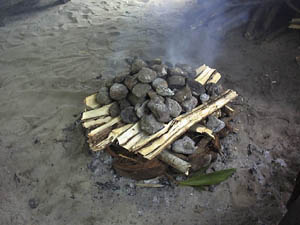
Preparing the um

Breadfruit placed on the um
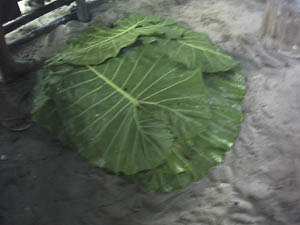
Steaming the um
I also learned how to make baskets today, as well as a local broom. Everything was made out of coconut leaves. The broom is made from the stems of each leaf on the coconut, which are then tied together to create a really nice broom that can reach into just about every nook and cranny you might want to clean. We used the basket to hold the breadfruit once it was cooked, and Magdalyn and I made local plates (also woven out of coconut) which were used not as plates but to cover the breadfruit.
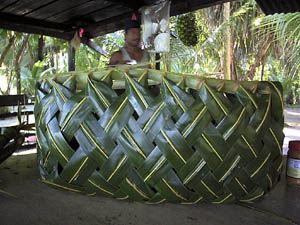
Basket made to hold the breadfruit

Making a local broom
July 1, 1999

Alik and the boat operator
We spend a half-day at the site today, as we are returning to Tofol with a pick-up time at about 2 this afternoon. With the brush cut, the crew concentrated on picking it off the ground in selected areas, while two of them continued with the stratigraphic trenches with me. We profiled the trench dug yesterday, and dug a second one which I made Stan profile. He has never done a stratigraphic profile before, so now was his chance.
Overall, there appears to be just four basic soil layers: the surface layer, which appears to exhibit a lot of disturbance and mixing with the underlaying layer; the midden layer, which is quite thick in places; an underlaying stable beach sand layer with no cultural materials present but lots of root discoloration; and below this an active beach sand layer, again with no indication of cultural materials present. Crab activity is very apparent and can be seen throughout the profiles. These guys have carried midden downward in their tunnels into the basal sand layers, mainly the stablized beach sands; so far their activity does not appear to penetrate the active beach layer.
Next week we will dig a third stratigraphic layer, begin our mapping, and start excavations in at least one of the heavier midden deposits.
It was really nice to listen to the waves, watch the sunset and the stars starting to come into view, waking up to a view of the lagoon through a big pandanus tree just as the sun was rising, watching dogs play on the beach, watching kids pole down the lagoon on errands early in the morning in a small outrigger canoe, listening to six big guys singing along to a current popular song (they brought a radio/tape/CD player that runs on batteries) and all in their best imitation of women sing "I feel like a woman."
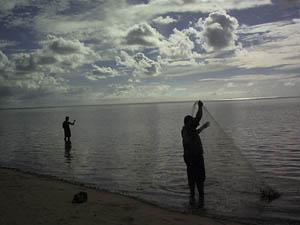
The boys fishing with nets
July 5, 1999
We were supposed to go to Walung today, but our departure is delayed. Stan and the crew have to attend a funeral in Malim. Funerals take precedence over anything out here.
July 6, 1999
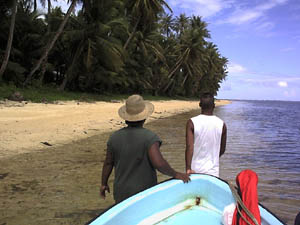
Arriving
We had to take two trips to the site. The first left from Utwe dock with four of the crew members; the second left from Okat and included me, a couple of the crew, Stan, his wife, and two of their younger daughters, Terrylyn and Mayleen the baby. This should be a true Andrew family outing with Stan, his wife, and three of their kids (Lydon being the third; he is on the crew).
The plan for today is to work half-day as we are going to have a barbecue and all must help in its preparations. We completed a third stratigraphic trench and concentrated on clearing the ground of more vegetation. I also tried to locate Nena's datum points from which to tie our own mapping efforts into his. I was unsuccessful, however, so I will have to tie into at least two if not three of his mapping points.
Tomorrow we start in earnest in our mapping and excavation. I have already picked out the area to start excavations, and will have Stan oversee these. His knee is bothering him, so I hope he will simply allow the crew to do the digging; they know the routine and are perfectly capable of doing the work. Stan, however, will need to make sure the paperwork is completed, like the level summaries for the excavations, catalogue numbers for the recovered materials, and so on. This is basically the beginning of the chain-of-custody for the recovered materials, so that they can ultimately be traced back to this site, this unit, this level, and this date.
Meanwhile, back at camp, the work has already begun for our barbecue. Elio Nena, our host, was busy chopping onions to season the chicken, while Magdalyn and her girls were busy preparing the lanterns. It was a chore keeping the dogs away from the cooking chicken; every once and a while one of them would steal a piece. The dogs are pretty funny. They generally scavenge for their food, and at night, when we are eating at the tables in the kitchen, each one will stake out a claim under each of us and await the scraps that inevitably fall off the plates.
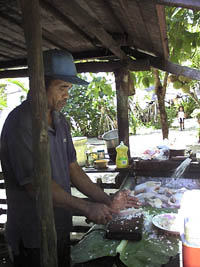
Elio Nena chopping onions
Next: Excavation and mapping
|
|
|